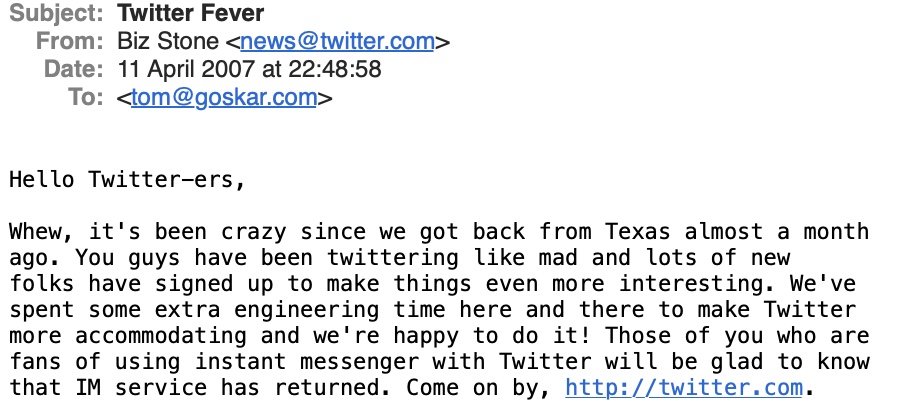I first heard about Twitter back in 2006. I wasn’t sure if I’d use it, and at that time you needed to have an invitation in order to keep a check on the growth of users. In February 2007 I was able to sign up. I was able to choose “@tag” (my initials) as my username and there were still plenty of three letter names available. I was user 754,587 – not even a million at that point.
It was a very different service back then. The community was smaller – indeed it actually felt like a community. Tweets were 140 characters. You could tweet via SMS. No hashtags. No ads, images, threads, lists etc. It was just a simple chronological timeline of tweets from people that you followed. Biz Stone sent out friendly emails to users about technical updates and news about investors. I loved it.
From a professional point of view, as a tech-savvy archaeologist with an MSc half taught in the Electronics and Computer Science department at Southampton University, Twitter helped to connect me with the tech world. At the time I was building a large website on a dedicated server and learning everything as I went along. Contacts and “RTs” – manual retweets – opened my eyes to the latest happenings in Content Management Systems, server administration, and even asking questions of some highly-regarded admins. Twitter was central to my development back then. I tweeted often, about everything. Maybe I even began to have 140 character thoughts. What could I tweet next?
As well as working with websites, I was also heavily engaged with 3D scanning and archaeological 3D reconstruction. Twitter helped me keep my feet in both areas. It was the place to get news and to meet people.
Twitter was the first mobile app that I ever used. First, updating by SMS was so easy to do. Then came reading the feed via a very slow 2G phone on a tiny screen via a Java app. Then in 2008 on my Nokia E71 it really arrived with its larger screen and amazing keyboard, and an app called Gravity. It was the first software on a phone that I had ever bought, and it really was superb for managing Twitter.
As Twitter got bigger and bigger, the signal to noise ratio started to get out of control. My username helped to make it all unusable. I wrote a blog post in 2009 called “Being @tag on Twitter” but to summarise, Facebook introduced @replys meaning that you could ‘tag’ your friends. Over on Twitter people gleefully started chattering that you could “@tag” your friends. Imagine the volume of notifications that I started receiving. There were a lot. I eventually had to change my username – that or abandon Twitter. So I changed it to @tomgoskar but things weren’t the same.
I still keep an eye on Twitter today, more than 15 years later. I don’t tweet very often, but I do manage some private lists to help me keep up in certain areas. But to be honest, it feels more like using an RSS aggregator sometimes. There are lots of retweets and announcements, and, anecdotally at least, not as much conversation. People have – as is the natural order of things – broken off to use Facebook or Instagram, chatting on Slack/Discord, or the deep dive that is Reddit. That’s the nature of things. When people have choice, they will choose!
With the latest news that Elon Musk, one of the richest people in the world, is to buy Twitter, I’m not sure what to think. He is known for being outspoken and somewhat erratic. He hopes to restore ‘free speech’ which I hope won’t mean that Twitter will once again welcome hate speech.
I’ve long felt that since Twitter is free to use, we, the users, are the product. We don’t really get a say on the features of the platform. I miss the many different Twitter clients that flourished before Twitter decided to cut most of them off. The open Twitter has been gone for a long time. We need to be able to pay for Twitter. I would certainly pay a small amount per month or year to get rid of ads and get some great tools for managing and refreshing my feeds. I don’t want any ranking algorithm going anywhere near my main or list feeds. I thought that Twitter Blue might be a step in this direction, but sadly not.
So once again, Twitter is at a crossroads. Once the go-to place for people to organise and get real-time news, it feels that it has become diluted. Audio ‘Spaces’, segregated ‘Communities’, privacy issues (Twitter tracks you and sells browsing and usage statistics), and so much more besides. Where will it go next? Will Elon Musk’s ownership be a blessing or a curse? Probably both. The New Yorker recently published a good summary of some of the claims and concerns over the takeover.
Let’s see what happens next, but like Flickr is currently doing, perhaps it’s time to refocus on the basics. Do one thing, and do it well.

